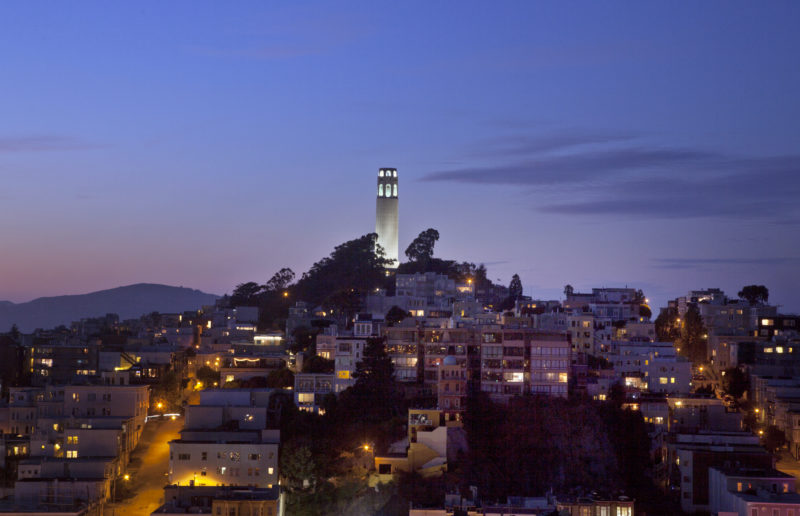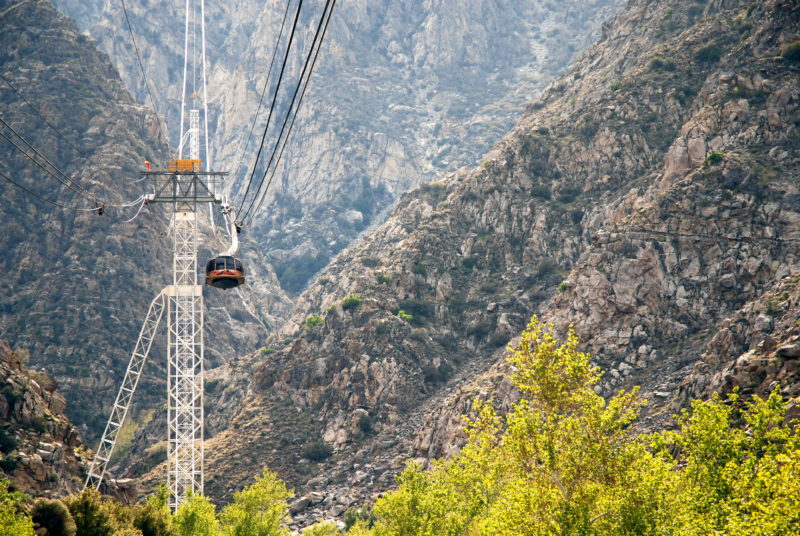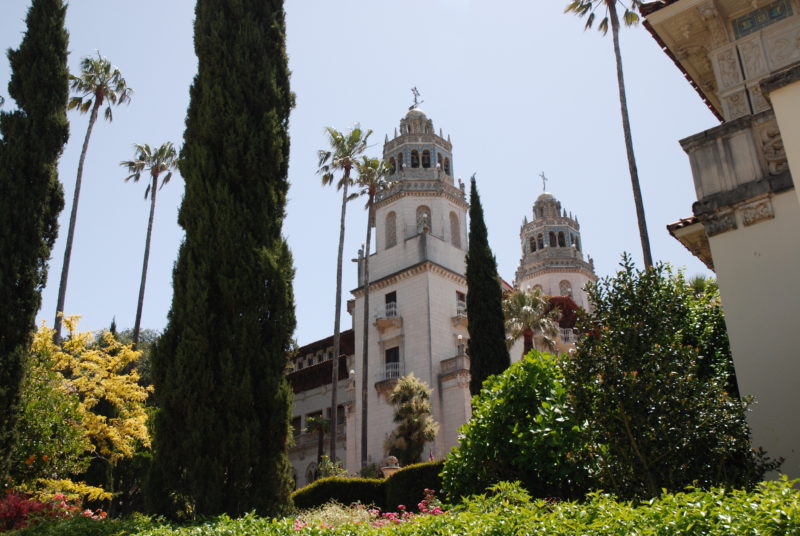Why do you travel? To see something new? To broaden your knowledge of the world? To expose your children to new adventures?
From architectural marvels like the Painted Ladies in San Francisco to the Palm Springs Aerial Tramway, travelers can find exciting destinations in California that are a testament to human ingenuity.
San Francisco

From the cable cars to Alcatraz and the Transamerica Pyramid, San Francisco teems with man-made marvels. I’ve listed San Francisco as a man-made marvel in, and of, itself. Here are a few “must sees” in the City by the Bay.

Coit Tower, 1 Telegraph Hill Blvd., San Francisco, 94133: At the summit of the historic Telegraph Hill in San Francisco sits the 210-foot Coit Tower. The elegant tapering column was built in 1933 at the request of San Francisco’s colorful Lillie Hitchcock Coit, who left a $125,000 bequest “for the purpose of adding beauty to the city which she had always loved.” The ground floor lobby is adorned with fresco murals by some 30 local artists. Depicting life in 1930s San Francisco, they are a colorful, insightful look at The Great Depression. Open daily 10 a.m.-5 p.m. (until 6 p.m. summer hours). Fee applies for tours and elevator. Info: https://sfrecpark.org/destination/telegraph-hill-pioneer-park/coit-tower
Golden Gate Bridge: The Golden Gate Bridge connects San Francisco to California’s northern counties. Constructed in 19 the bridge features 746-foot tall towers, sweeping main cables, signature International Orange color and Art Deco styling. Visitor experiences are centered around an all new Bridge Plaza at the southeast end. Tolls apply to drive across the bridge. Pedestrians are allowed access only on the East Sidewalk (side facing San Francisco). The hours vary seasonally: Pacific Standard Time 5 a.m. to 6:30 p.m. Daylight Savings Time 5 a.m. to 9 p.m. Info: https://goldengatebridge.org/visitors
(My favorite way to see the Golden Gate Bridge is to take a boat tour that travels under the bridge. Info: www.city-sightseeing.us/products/san-francisco-bay-cruise).
Painted Ladies, 710 to 720 Steiner St., San Francisco, 94117: About 48,000 houses in the Victorian and Edwardian styles were built in San Francisco between 1849 and 1915 and many were painted in bright colors. Many Nob Hill mansions were destroyed by the 1906 San Francisco earthquake, but thousands of the mass-produced, more modest houses survived in the western and southern neighborhoods of the city. One of the best-known groups of “Painted Ladies” is the row of Victorian houses at 710-720 Steiner Street, across from Alamo Square park. The houses were built between 1892 and 1896 by developer Matthew Kavanaugh, who lived next door in the 1892 mansion at 722 Steiner St. Info:

Camera Obscura, 1096 Point Lobos Ave., San Francisco, 94121: The Camera Obscura in San Francisco was added to the National Register of Historic Places in 2001. It is a large-scale camera obscura located near the Cliff House restaurant perched on the headlands on the cliffs just north of Ocean Beach on the western side of San Francisco. The Camera and restaurant are currently owned by the National Park Service as part of the Golden Gate National Recreation Area. Cameras obscura, devices which project an image of the surroundings onto a surface using only existing exterior light sources, usually sunlight, have a long history in San Francisco. The Camera was installed in 1946 and has been in continuous operation since. Info: https://www.nps.gov/goga/planyourvisit/cliff-house-sutro-baths.htm
Battery Point Lighthouse

Lighthouse Way, Crescent City, 95531
For more than 150 years, the Battery Point Lighthouse has aided coastal navigation in. It is registered as a California Historical Landmark and is listed on the National Register of Historic Places.
In May 1855, Congress appropriated $15,000 for the construction of the lighthouse.
Unlike many historic lighthouses, it is still active with a lightkeeper in residence. Legends abound about its Native American ties as well as the resident ghost said to haunt the building. Crossing during low tide to get there affords stunning views of the California coast.
Del Norte Historical Society operates the Battery Point Lighthouse and Museum. The lighthouse is open to the public only when low tide permits access, daily from April through September with tours between 10 a.m. and 4 p.m. Info: https://lighthousefriends.com/light.asp?ID=58
Los Angeles Aqueduct
17001 Foothill Blvd., Sylmar, 91342
Los Angeles has many important and iconic structures; however, nothing compares with the significance of the Los Angeles Aqueduct in the history of L.A.
The aqueduct project began in 1905 when the voters of Los Angeles approved a bond to purchase lands and water and start the planning of the aqueduct. Construction began in 1908 and the first phase was completed in 1913. When completed in 1913, the Los Angeles Aqueduct was considered to be a great engineering accomplishment only second to the Panama Canal.
The aqueduct uses gravity alone to move the water and also uses the water to generate electricity.
The best place to view the historic aqueduct, which still moves massive amounts of water to L.A., at the junction of Balboa Boulevard and Foothill Road in the San Fernando Valley (From the 5 Freeway, exit Roxford Street and head east to Foothill Boulevard, turn left. Park on the second Balboa Boulevard, near County Assessor’s Office and walk to Cascades).
The location of the Los Angeles Aqueduct Cascades in Sylmar is the most visible part of the L.A. Aqueduct to Angelenos.
It features the century-old L.A. Aqueduct (the shorter, zig-zagging channel on the left as you face the aqueduct) and the 43-year-old Second L.A. Aqueduct, built in 1965 (the long channel on the right).
The Aqueduct also runs literally through people’s backyards in the Santa Clarita Valley. It is most visible as that giant pipe seen at Saugus High School (21900 Centurion Way, Saugus, 91350) and adjacent to the Walmart-anchored shopping center in Golden Valley (26471 Carl Boyer Drive, Saugus, 91350). Sit on the bench at the edge of the parking lot for a good view. Info: www.ladwp.com/ladwp/faces/ladwp/aboutus/a-water/a-w-losangelesaqueduct
Palm Springs Aerial Tramway

1 Tram Way, Palm Springs, 92262
Hop on the Palm Springs Aerial Tramway, the world’s largest rotating tram car, to experience 360-degree desert vistas of Chino Canyon and Mt. San Jacinto Park. After ascending to 8,500 feet, travelers can enjoy more than 50 miles of hiking trails, a natural history museum and observation platforms that offer breathtaking views and unlimited photo opportunities.
The tramway was completed in 1963 after it was first conceived in 1935. Hours: Variable. Fees apply. Info: https://www.pstramway.com
Hearst Castle

750 Hearst Castle Road, San Simeon, 93452
Few buildings on earth are as elaborate as Hearst Castle, both a National Historic Landmark and California Historical Landmark. The 165-room estate of publishing magnate William Randolph Hearst is located high above the village of San Simeon atop a hill he called La Cuesta Encantada (“the Enchanted Hill”).
One of the last great estates of America’s Gilded Age, it’s an over-the-top monument to wealth. Construction began in 1919 and continued until 1947.
Hearst Castle has a total of 42 bedrooms, 61 bathrooms and 19 sitting rooms. The estate contains 127 acres of gardens, terraces, pools and walkways perched 1,600 feet above sea level (and often above the fog level). It can only be seen by guided tours. Tours sell out so it is important to reserve your tickets before you go.
Info: https://hearstcastle.org
Winchester Mystery House
525 S Winchester Blvd, San Jose, 95128
Convinced that the evil spirits of those killed with Winchester guns would only be appeased by perpetual construction on her mansion, heiress Sarah L. Winchester used much of her $20-million inheritance to finance the construction of the Winchester Mystery House, which started in 1884 and went on 24 hours a day, 7 days a week, 365 days a year, for 38 years.
With 160 rooms, the home sprawls across a half-dozen acres and is full of disturbing features: a staircase leading nowhere, a Tiffany window with a spider-web design, and doors that open onto blank walls. Such schemes were designed to confound the spirits that allegedly plagued the heiress.
Hours: Open daily at 9 a.m., closing times vary. Fees apply for tours. Info: https://winchestermysteryhouse.com
California State Capitol

10th and L Streets, Sacramento, 95814 If you’ve never been to the U.S. Capitol in Washington, D.C., California has a very close replica in Sacramento. Serving as both a museum and the state’s working seat of government, the California State Capitol building was constructed in 1869 and underwent an extensive renovation in 1976. It was returned to its turn-of-the-century décor. Free admission and hourly tours. Open daily 9 a.m.-5 p.m. Visit your State Senator and Assemblyperson when you visit. State Senator Scott Wilk (https://wilk.cssrc.us) and Assembly Member Christy Smith (https://a38.asmdc.org). Info: www.assembly.ca.gov/statecapitol












